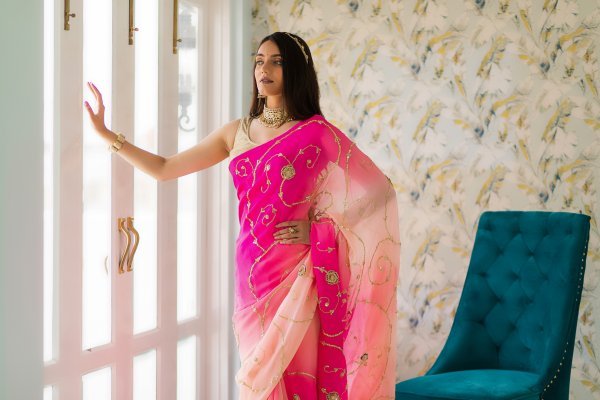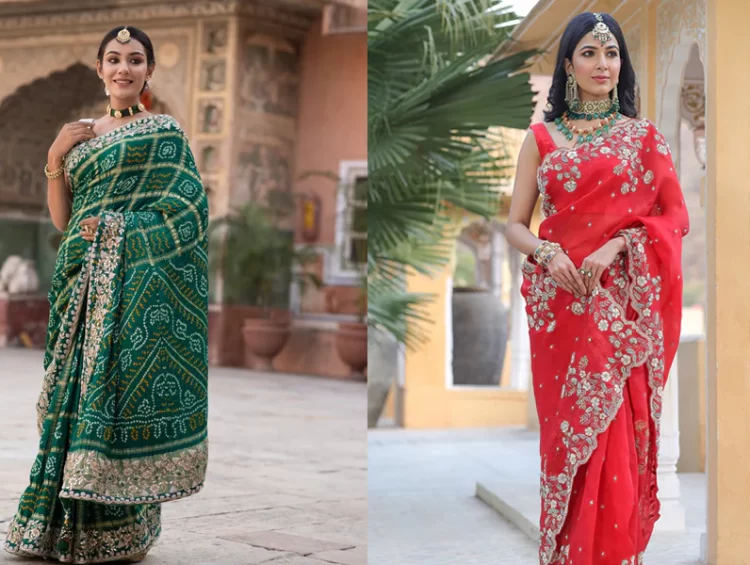Sarees, an iconic symbol of Indian culture, are much more than a traditional garment. Worn on various occasions from daily wear to grand celebrations, sarees have evolved in style, pattern, and most importantly, the materials they are made from. The fabric of a saree greatly influences its appearance, feel, and appropriateness for different occasions. In this article, we’ll explore the diverse materials used to make sarees, shedding light on the specialty of each fabric and how it adds to the charm of this timeless attire.
1. Silk Sarees: The Quintessential Luxury
When you think of premium sarees, silk is the first fabric that often comes to mind. Known for its luxurious sheen, smooth texture, and regal drape, silk sarees have been worn by royalty for centuries. There are many types of silk sarees, with Banarasi, Kanjivaram, and Mysore silk being among the most famous. The intricate weaving of these sarees, often with gold and silver threads, makes them a must-have for weddings and other ceremonial occasions.
The specialty of silk lies in its opulence and versatility. Whether plain or heavily embroidered, silk sarees always exude elegance and sophistication, making them perfect for grand events. Furthermore, silk’s natural ability to regulate temperature keeps the wearer comfortable in both warm and cool climates.
2. Cotton Sarees: The Epitome Of Comfort
For everyday wear, nothing beats the comfort and breathability of cotton. Cotton sarees are lightweight, soft, and ideal for hot and humid climates. These sarees come in a variety of prints and weaves, such as handloom cotton sarees, which showcase traditional craftsmanship. The specialty of cotton sarees lies in their simplicity and ease of wear. They are perfect for casual occasions, office wear, or even a day out shopping.
Despite their simple appearance, cotton sarees can be styled in various ways to make a fashion statement. Pair them with statement jewelry or a designer blouse to add a touch of glamor to an otherwise simple outfit.

3. Chiffon Sarees: Lightweight Elegance
Chiffon sarees are known for their lightweight, sheer fabric that drapes beautifully around the body. This fabric is especially favored by women who prefer a modern, sleek look without compromising on elegance. The flowy nature of chiffon allows it to create a stunning silhouette, enhancing the wearer’s figure in a flattering way.
The specialty of chiffon sarees is their ability to strike a balance between traditional and contemporary styles. Chiffon is also highly versatile, making it a great option for both casual and formal occasions. From vibrant colors to subtle pastels, chiffon sarees come in a wide range of hues and prints, making them a popular choice for women who want an understated yet stylish look.
4. Georgette Sarees: A Blend of Grace and Durability
Georgette sarees are often compared to chiffon due to their lightweight texture, but they are slightly heavier and more durable. Georgette fabric is crinkled, giving the saree a slightly textured look. These sarees are often embellished with intricate embroidery, sequins, and beads, making them perfect for festive and formal occasions.
The specialty of georgette lies in its combination of grace and sturdiness. Unlike more delicate fabrics, georgette sarees are durable and easy to maintain, making them a practical choice for women who want to invest in a saree that will last for years.
Conclusion
The material used to make sarees plays a significant role in determining their look, feel, and appropriateness for various occasions. Whether you prefer the luxury of silk, the comfort of cotton, or the glamour of net, there’s a fabric for every taste and occasion. Each fabric brings its own unique specialty, allowing sarees to remain one of the most versatile and beloved garments in the world. Next time you buy sarees, consider the material carefully to ensure you choose the perfect one for your needs.





